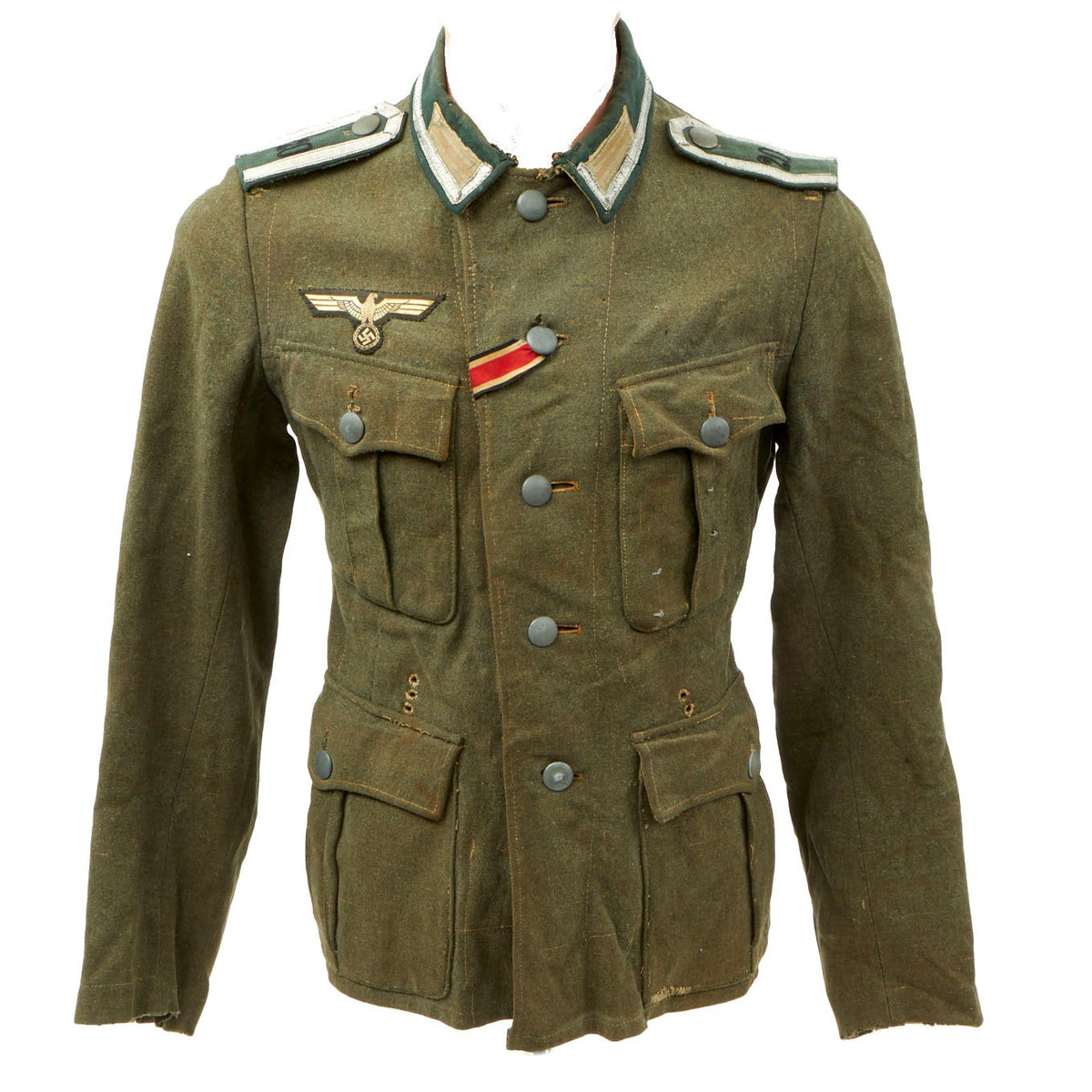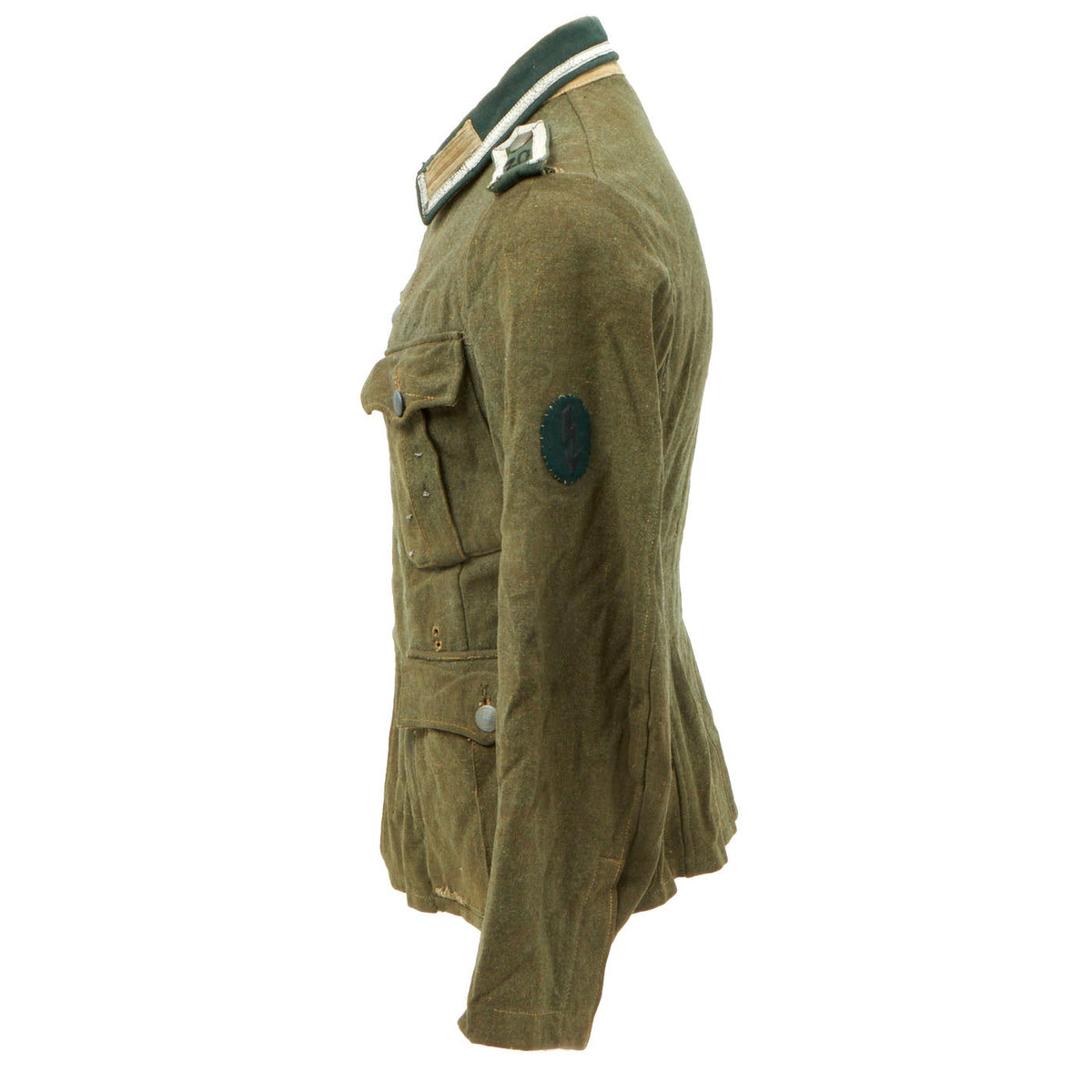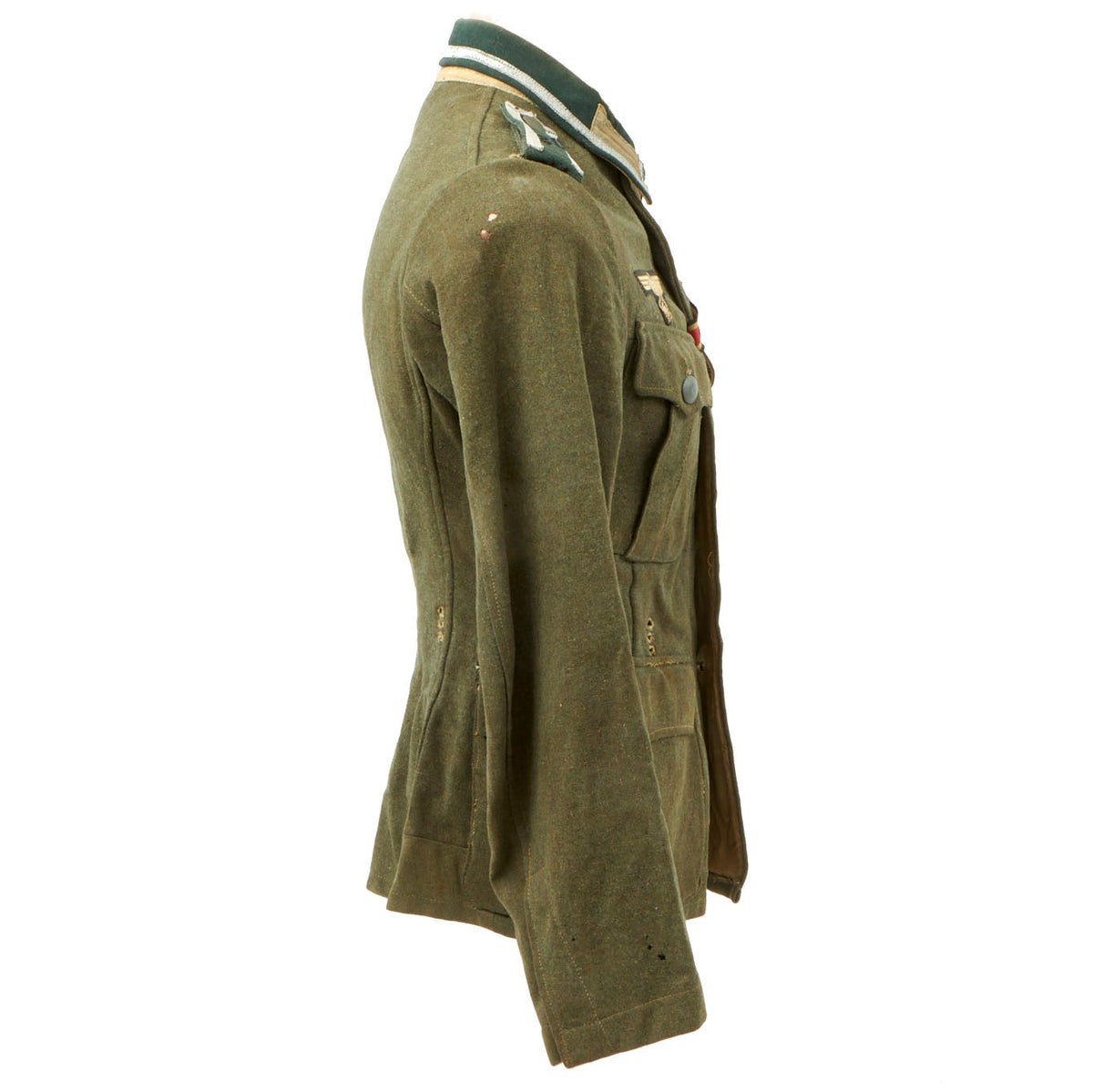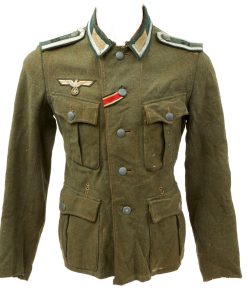Original German WWII Early War M36 Heer Army Tunic – Combat Worn Original Items
$ 1.795,00 $ 448,75
Original Item: Only One Available. This is a very salty, combat worn tunic. There are various field repairs and stitching done throughout the tunic and they appear to be period original repairs. The tunic features four pockets with scalloped flaps and pebbled aluminum buttons. The attractive Army breast eagle is machine embroidered, and is very neatly hand stitched to the chest in a fashion typical of wartime German tailor work, unfortunately some of the thread has worn away and discoloration is present. There is only one award present on the uniform and it is a “buttonhole” ribbon for an Iron Cross 2nd Class and is affixed through the second buttonhole. The shoulder boards are not the sewn on type and are fixed through the loops and attached with the button. The number 20 is embroidered in black on the all green and silver trip shoulder boards.
Individual units were identified by the use of numbers and, sometimes, letters or symbols on the straps & boards. By regulation, these designators were embroidered for enlisted men and junior NCOs (Unteroffizier and Unterfeldwebel) and metal for Feldwebel and above. The embroidered varieties were done in the wearer’s branch color, with the metal devices in silver or aluminum for senior NCOs. When an Unteroffizier got promoted to Unterfeldwebel it was a simple matter to add the NCO tress bar across the base of the strap. This is frequently hand-stitched, especially on sew-in straps. Straps produced for the ranks of Unterfeldwebel and above will have the tress uniformly machine-sewn. After January of 1940, straps with unit insignia were no longer to be produced.
Other items featured on this tunic is a patch on the left shoulder sleeve for a Heer Signals Operator. The patch is in good condition but does have some mothing present. The Signal Corps or Nachrichtentruppe des Heeres, in the sense of signal troops, was an arm of service in the army of the German Wehrmacht and Waffen SS, whose role was to establish and operate military communications, especially using telephone and radio networks.
By order of the Oberkommando der Wehrmacht dated 14 Oct 1942, it was part of the combat arms of the German Wehrmacht and Waffen SS until 1945.
This tunic is a very beautiful example of a heavily worn salty Heer early war tunic. This M36 is welcomed into any WWII Wehrmacht collections and comes ready to display!
Measurements:
Collar to Shoulder: 9”
Shoulder to Sleeve: 21”
Shoulder to Shoulder: 18”
Chest Width: 16”
Waist Width: 15”
Hip Width: 15”
Front Length: 24”
The following is a general overview of the Heer main uniforms, used by the German army prior to and during World War II.
Terms such as M40 and M43 were never designated by the Wehrmacht, but are names given to the different versions of the Model 1936 field tunic by modern collectors, to discern between variations, as the M36 was steadily simplified and tweaked due to production time problems and combat experience.
Uniforms of the Heer as the ground forces of the Wehrmacht were distinguished from other branches by two devices: the army form of the Wehrmachtsadler or Hoheitszeichen (national emblem) worn above the right breast pocket, and – with certain exceptions – collar tabs bearing a pair of Litzen (Doppellitze “double braid”), a device inherited from the old Prussian Guard which resembled a Roman numeral II on its side. Both eagle and Litzen were machine-embroidered or woven in white or grey (hand-embroidered in silk, silver or aluminium for officers). Rank was worn on shoulder-straps except for junior enlisted (Mannschaften), who wore plain shoulder-straps and their rank insignia, if any, on the left upper sleeve. NCO’s wore a 9mm silver or grey braid around the collar edge.
Shoulder-straps and, in many cases, collar patches were piped or underlaid in Waffenfarbe, a color code which identified the branch of service to which the unit belonged: white for infantry, red for artillery, rose-pink for Panzer troops and so on.
Fast Shipping with Professional Packaging
Thanks to our longstanding association with UPS FedEx DHL, and other major international carriers, we are able to provide a range of shipping options. Our warehouse staff is expertly trained and will wrap your products according to our exact and precise specifications. Prior to shipping, your goods will be thoroughly examined and securely secured. We ship to thousands clients each day across multiple countries. This shows how we're dedicated to be the largest retailer on the internet. Warehouses and distribution centres can be located throughout Europe as well as the USA.
Note: Orders with more than one item will be assigned a processing date depending on the item.
Before shipping before shipping, we'll conduct a thorough inspection of the items you have ordered. Today, the majority of orders will be delivered within 48 hours. The delivery time will be between 3-7 days.
Returns
The stock is dynamic and we cannot completely manage it because multiple stakeholders are involved, including our factory and warehouse. So the actual stock may alter at any time. It's possible that you may not receive your order once the order has been made.
Our policy is valid for a period of 30 days. If you don't receive the product within 30 days, we are not able to issue a refund or an exchange.
You can only return an item if it is unused and in the same state as the day you received it. You must have the item in its original packaging.
Related products
Uncategorized
Australian WWII Owen MK1 Machine Carbine SMG Custom Fabricated Replica with Sling Original Items
Uncategorized
Uncategorized
Armoured Fighting Vehicles of the World: AFVs of World War One (Hardcover Book) New Made Items
Uncategorized
Uncategorized
Band of Brothers ORIGINAL GERMAN WWII Le. F.H. 18 10.5cm ARTILLERY PIECE Original Items
Uncategorized
Uncategorized
Uncategorized
Uncategorized
Uncategorized
Uncategorized
Uncategorized
Uncategorized
Uncategorized
Uncategorized
Uncategorized
Uncategorized












































































